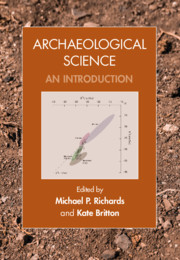Book contents
- Archaeological Science
- Archaeological Science
- Copyright page
- Contents
- Figures
- Tables
- Contributors
- Acknowledgements
- Part I Introduction
- Part II Biomolecular Archaeology
- Part III Bioarchaeology
- Part IV Environmental Archaeology
- 10 Vertebrate Zooarchaeology
- 11 Invertebrate Zooarchaeology
- 12 Palaeoethnobotany
- 13 Geoarchaeology
- Part V Materials Analysis
- Part VI Absolute Dating Methods
- Index
- References
12 - Palaeoethnobotany
from Part IV - Environmental Archaeology
Published online by Cambridge University Press: 19 December 2019
- Archaeological Science
- Archaeological Science
- Copyright page
- Contents
- Figures
- Tables
- Contributors
- Acknowledgements
- Part I Introduction
- Part II Biomolecular Archaeology
- Part III Bioarchaeology
- Part IV Environmental Archaeology
- 10 Vertebrate Zooarchaeology
- 11 Invertebrate Zooarchaeology
- 12 Palaeoethnobotany
- 13 Geoarchaeology
- Part V Materials Analysis
- Part VI Absolute Dating Methods
- Index
- References
Summary
Palaeoethnobotany (or archaeobotany1) can be defined as the study of the interrelationships between ancient peoples and plants based on the identification and interpretation of plant remains recovered from archaeological sites (Ford 1979; Helbaek 1959). Archaeobotanical remains are often classified into two analytical groups: macro- and microbotanical remains. This distinction relates to whether or not botanical specimens are visible (macro) or invisible (micro) to the unaided eye. Studies of macrobotanical remains have typically focussed on seeds (and seed-like fruits), fruits, nuts, wood charcoal (e.g., Pearsall 2000: 11–247; Thiébault 2002), and roots/tubers/parenchyma (Hather 1993). The study of wood charcoal, or anthracology, is a multidisciplinary field involving archaeologists, palaeoecologists, and conservationists (e.g., Chabal 1997; Cabanis and Marguerie 2013; Théibault 2002; Vernet et al. 2001). Investigations of microbotanical remains have concentrated on pollen (e.g., Bryant and Holloway 1983; Bryant and Holloway 1996), phytoliths (e.g., Pearsall 2000: 355–496; Piperno 2006b; Piperno and Pearsall 1993), and starch (e.g., Loy 1994; Torrence and Barton 2006). Microbotanical remains can also include diatoms (Juggins and Cameron 1999) and biomolecular remains such as plant DNA (e.g., Brown et al. 2015; Schlumbaum et al. 2008), and lipids (e.g., Evershed 1993), however, these analyses are typically not completed by palaeoethnobotanists.
- Type
- Chapter
- Information
- Archaeological ScienceAn Introduction, pp. 276 - 313Publisher: Cambridge University PressPrint publication year: 2020
References
- 1
- Cited by



